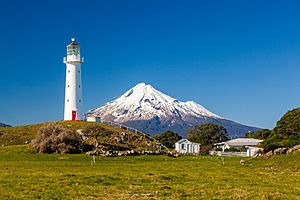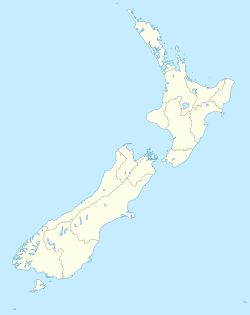Cape Egmont Lighthouse facts for kids
 |
|
| Cape Egmont and Mount Taranaki | |
|
|
|
| Location | Cape Egmont, North Island, New Zealand |
|---|---|
| Coordinates | 39°16′34.4″S 173°45′18.1″E / 39.276222°S 173.755028°E |
| Year first constructed | 1881 |
| Automated | 1986 |
| Construction | cast iron tower |
| Tower shape | cylindrical tower with balcony and lantern |
| Markings / pattern | white tower and lantern |
| Height | 20 metres (66 ft) |
| Focal height | 33 metres (108 ft) |
| Range | 19 nautical miles (35 km; 22 mi) |
| Characteristic | Fl W 8s. |
| Admiralty number | K4088 |
| NGA number | 4788 |
| ARLHS number | NZL-007 |
The Cape Egmont Lighthouse is a famous lighthouse located at Cape Egmont. This spot is in the Taranaki Region on the North Island of New Zealand. It helps guide ships safely along the coast.
Contents
Discover the Cape Egmont Lighthouse
This important lighthouse is owned and looked after by Maritime New Zealand. It stands tall, helping sailors find their way, especially at night. Lighthouses are like giant beacons that send out light signals. These signals help ships know where they are and avoid dangerous areas.
A Lighthouse with a Journey
The Cape Egmont Lighthouse has an interesting history. It wasn't always in its current spot!
Built in London
The light for the lighthouse was first made in 1864. It was built by a company called Simpson & Co. in Pimlico, London. This means the main part that shines the light traveled a long way to New Zealand.
First Home: Mana Island
In 1865, the lighthouse was first put up on Mana Island. This island is located to the northwest of Porirua. It served its purpose there for a few years.
A Confusing Light
However, there was a problem. Sometimes, sailors got confused. The light from the Mana Island lighthouse looked too much like the light from the Pencarrow Head lighthouse. The Pencarrow Head light is at the entrance to Wellington Harbour. This confusion could be dangerous for ships.
Moving to Cape Egmont
To solve this problem, a big decision was made. In 1877, the lighthouse was taken apart. All its pieces were carefully moved from Mana Island to Cape Egmont. It was then put back together in its new home. This shows how important it was to have clear, distinct lights for navigation.
Modern Times: Automation
For many years, people called "lighthouse keepers" lived at the lighthouse. They were responsible for making sure the light was working properly. They would light the lamp and keep everything in order.
However, technology changed. In 1986, the Cape Egmont Lighthouse became fully automated. This means it no longer needed people to operate it. Machines took over the job of keeping the light shining. It now works all by itself, powered by electricity.


